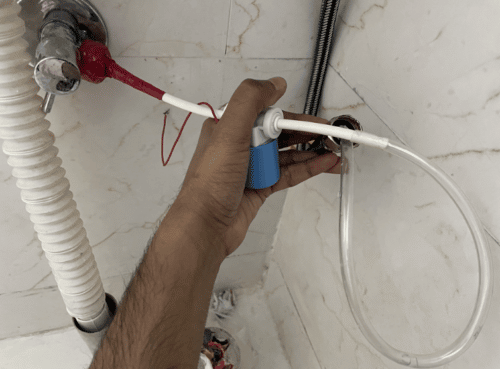 Water conservation is one of the important factors, as knowingly or unknowingly we waste water every day in some way, like when we forget to turn off the taps and showers in our homes and mostly in public places.
Water conservation is one of the important factors, as knowingly or unknowingly we waste water every day in some way, like when we forget to turn off the taps and showers in our homes and mostly in public places.
Innovative taps that turn on when they detect you and turn off later were developed using a variety of technologies to get around this problem.
However, the design of those smart taps is based on either a motion sensor or an IR sensor, which was not suitable for the majority of cases because the motion sensors or using IR sensors failed to work in strong light or outside sunlight, which is why the majority of taps are left on and water is wasted at public taps.
We previously build the Smart Water Tap.
An alternative design was an ultrasonic-based tap, but it requires a microcontroller and numerous other parts to perform calculations and sense things in order for it to function.
Hence, we have come up with a reliable design using microwave radar that costs only 70 to 50 rupees.

Full Video Explaination:
Bill of Materials

Automatic Touchless Water Tap Circuit
Connect the relay module input pin to the out pin of the RCWL 0516.
Next, we connect the 12V solenoid valve to the relay module NO pin and the 12V DC wire of the 12V adapter to the common pin of the relay.
And connect the GND wire to the GND or -Ve pin of the 12V adapter.
Connect all the components according to the following circuit diagram.

Working
Here RCWL-0516 microwave radar human sensor is used; the sensor consists of 4 pins, of which one is output and the other two are VCC and GND pins. The radar sensor emits a microwave around itself, and if any human comes near it, the microwave gets reflected, and the sensor detects the presence of a human by giving a signal using the output pin.
Setting up Automatic Touchless Water Tap
Now connect the hose to the output of your basin sink; further, connect the output of the hose to a pipe and connect this pipe to the inlet of the solenoid valve.
After that connect the output of the pipe to the input of the water tap pipeline.
Now connect the component to the 5V dc adapter and the 12V dc adapter for the 12V relay, and then place the RCWL sensor behind the tap or sink basin (Refer to Fig. 3, 4, 5 below).
Since the radar sensor is based on the microwave, it can penetrate a thin layer of ceramic, wood, or plastic, so you can either hide the sensor or design a custom sink made of thin ceramic and place the sensor behind that.
This is another beauty of this design: your sensor can be completely hidden behind the tap, ceramic tile, or thin plastic layer while it gives you 360-degree sensing.



Testing

Now, after connecting all components, place your hand near the microwave sensor, the relay turns on and the valve gets open and water starts flowing from the tap. Whenever you place your hand back, it turns off again in a few seconds.
If you face any issues while making this project, please feel to ask in the comments below.
Also, you can join our Forum to start the technical discussions with the community of electronics engineers.








Great,.